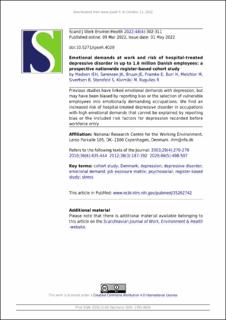| dc.contributor.author | Madsen, Ida E.H. | |
| dc.contributor.author | Sørensen, Jeppe Karl | |
| dc.contributor.author | Bruun, Julie Eskildsen | |
| dc.contributor.author | Framke, Elisabeth | |
| dc.contributor.author | Burr, Hermann | |
| dc.contributor.author | Melchior, Maria | |
| dc.contributor.author | Sivertsen, Børge | |
| dc.contributor.author | Stansfeld, Stephen A. | |
| dc.contributor.author | Kivimäki, Mika | |
| dc.contributor.author | Rugulies, Reiner | |
| dc.date.accessioned | 2022-10-26T09:33:50Z | |
| dc.date.available | 2022-10-26T09:33:50Z | |
| dc.date.created | 2022-10-13T14:43:44Z | |
| dc.date.issued | 2022 | |
| dc.identifier.citation | Scandinavian Journal of Work, Environment and Health. 2022, 48 (4), 302-311. | en_US |
| dc.identifier.issn | 0355-3140 | |
| dc.identifier.uri | https://hdl.handle.net/11250/3028367 | |
| dc.description.abstract | Objective Previous studies on effects of emotional demands on depression have relied on self-reported exposure data and lacked control for potential confounding by pre-employment risk factors for depression. This study used a register-based design to examine the risk of hospital-treated depressive disorder in relation to occupational levels of emotional demands at work, furthermore addressing the role of risk factors for depression before workforce entry. Methods We analyzed data from two Danish register-based cohorts – Job Exposure Matrix Analyses of Psychosocial Factors and Healthy Ageing in Denmark (JEMPAD, N= 1 665 798) (17) and Danish Work Life Course Cohort (DaWCo, N=939 411), which link assessments of emotional demands by job exposure matrices to records of hospital-treated depressive disorder among employees aged 15–59 years at baseline (average follow up: 9.7 years in JEMPAD, 7.3 years in DaWCo). Potential confounders comprised sociodemographics, job control, work-related violence and physical demands at work. In DaWCo, we followed individuals from their entry into the workforce, and also included data on risk factors for depression before workforce entry (eg, parental income, education, and psychiatric diagnoses). Results Employees in occupations with high emotional demands had an increased risk of hospital-treated depressive disorder with confounder-adjusted hazard ratios of 1.32 [95% confidence interval (CI) 1.24‒1.41] and 1.19 (95% CI 1.09‒1.30) in JEMPAD and DaWCO, respectively. This association remained after controlling for risk factors before workforce entry. Conclusions This study suggests that employees in occupations with high emotional demands are at increased risk of hospital-treated depressive disorder. This increased risk was neither attributable to reporting bias nor explained by the included risk factors for depression recorded before workforce entry. | en_US |
| dc.description.abstract | Emotional demands at work and risk of hospital-treated depressive disorder in up to 1.6 million Danish employees: a prospective nationwide register-based cohort study | en_US |
| dc.language.iso | eng | en_US |
| dc.publisher | Nordic Association of Occupational Safety and Health (NOROSH) | en_US |
| dc.rights | Navngivelse 4.0 Internasjonal | * |
| dc.rights.uri | http://creativecommons.org/licenses/by/4.0/deed.no | * |
| dc.title | Emotional demands at work and risk of hospital-treated depressive disorder in up to 1.6 million Danish employees: a prospective nationwide register-based cohort study | en_US |
| dc.title.alternative | Emotional demands at work and risk of hospital-treated depressive disorder in up to 1.6 million Danish employees: a prospective nationwide register-based cohort study | en_US |
| dc.type | Peer reviewed | en_US |
| dc.type | Journal article | en_US |
| dc.description.version | publishedVersion | en_US |
| dc.source.pagenumber | 302-311 | en_US |
| dc.source.volume | 48 | en_US |
| dc.source.journal | Scandinavian Journal of Work, Environment and Health | en_US |
| dc.source.issue | 4 | en_US |
| dc.identifier.doi | 10.5271/sjweh.4020 | |
| dc.identifier.cristin | 2061247 | |
| cristin.ispublished | true | |
| cristin.fulltext | original | |
| cristin.qualitycode | 1 | |

